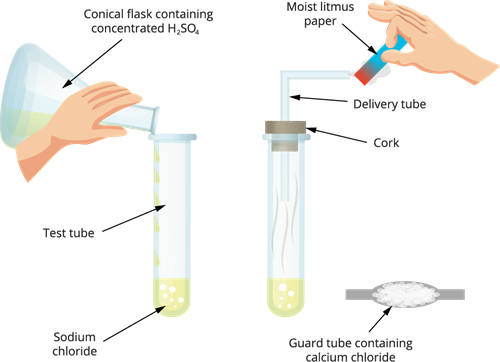
PUMPA - SMART LEARNING
எங்கள் ஆசிரியர்களுடன் 1-ஆன்-1 ஆலோசனை நேரத்தைப் பெறுங்கள். டாப்பர் ஆவதற்கு நாங்கள் பயிற்சி அளிப்போம்
Book Free DemoWe know that acid contains H^+ ions which are responsible for the conduction of electricity. Let us now test to see if these ions are produced only in the presence of an aqueous solution or not with the help of an experiment.
Example:
Activity 1: Experiment to prove acid produces (H^+\) ion in water.
Apparatus required:
- Blue litmus paper
- Rubber cork
- Test tube
- Sulphuric acid
- Solid sodium chloride
- Delivery tube
Step 1: Using approximately 1g solid NaCl in a clean and dry test tube, set up the apparatus as shown in the figure.
Step 2: Fill the test tube with concentrated sulphuric acid and fit the rubber cork in the test tube.
Step 3: Attach the delivery tube to the opening present in the rubber cork.
Step 4: What do you notice? Is gas escaping from the delivery tube?
- We can see the gas HCl coming out of the test tube.
Step 5: Using dry and wet blue litmus paper, test the gas evolution in stages.
Step 6: In what circumstances does the litmus paper change colour?
Step 6: In what circumstances does the litmus paper change colour?

Acid produces (H^+\) ion in water
Observation :
- When we place the dry litmus paper near the delivery tube, the HCl gas do not react with it leaving the colour unchanged.
- When we place the wet litmus paper near the delivery tube, the HCl gas react with the litmus paper and changes the colour to red.
Result: We can observe the change only in the case of wet blue litmus paper.
What conclusions would you draw about the acidic nature of dry HCl gas and HCl solution based on the above activity?
1. Dry HCl gas: Dry HCl gas does not have separate H^+ ions, due to which it fails to turn blue litmus paper to red. Hence, they do not show the acidic character of an acid. This case is similar to all acids.
2. HCl solution: It contains separate H^+ ions, due to which HCl solution turns blue litmus red and proves the acidic character of an acid.
This experiment proves that hydrogen ions in HCl solution are produced in the presence of water.
Therefore, the chemical equation can be written as,
HCl + H_2O\rightarrow H_3O^+ + Cl^-
Hydrogen ions cannot exist alone, so they exist by combing with water molecules. Thus, hydrogen ions must be shown as H^+ or hydronium ion H_3O^+.
Therefore, H^+ + H_2O\rightarrow H_3O^+
Thus, we can conclude that acids give H_3O^+ or H^+ (aq) ion in water.
Let us now see what happens to a base when dissolved in water:
As we also know that they are electrolytes and conduct electricity. Hence, we can confirm that bases separate into their ions in the presence of water.
Therefore, the chemical equation can be written as,
NaOH (s) + H_2O\rightarrow Na^+(aq) + OH^-(aq)
KOH (s) + H_2O\rightarrow K^+(aq) + OH^-(aq)
Mg(OH)_2 (s) + H_2O\rightarrow Mg^{2+}(aq) + 2OH^-(aq)
Hence, we can conclude by saying that bases produce hydroxide ions OH^- when dissolved in water. Therefore, the bases which are soluble in water are called alkalis.
Now, we know that all acids produce H^+ ions and all bases produce hydroxide ions OH^- ions in an aqueous solution.